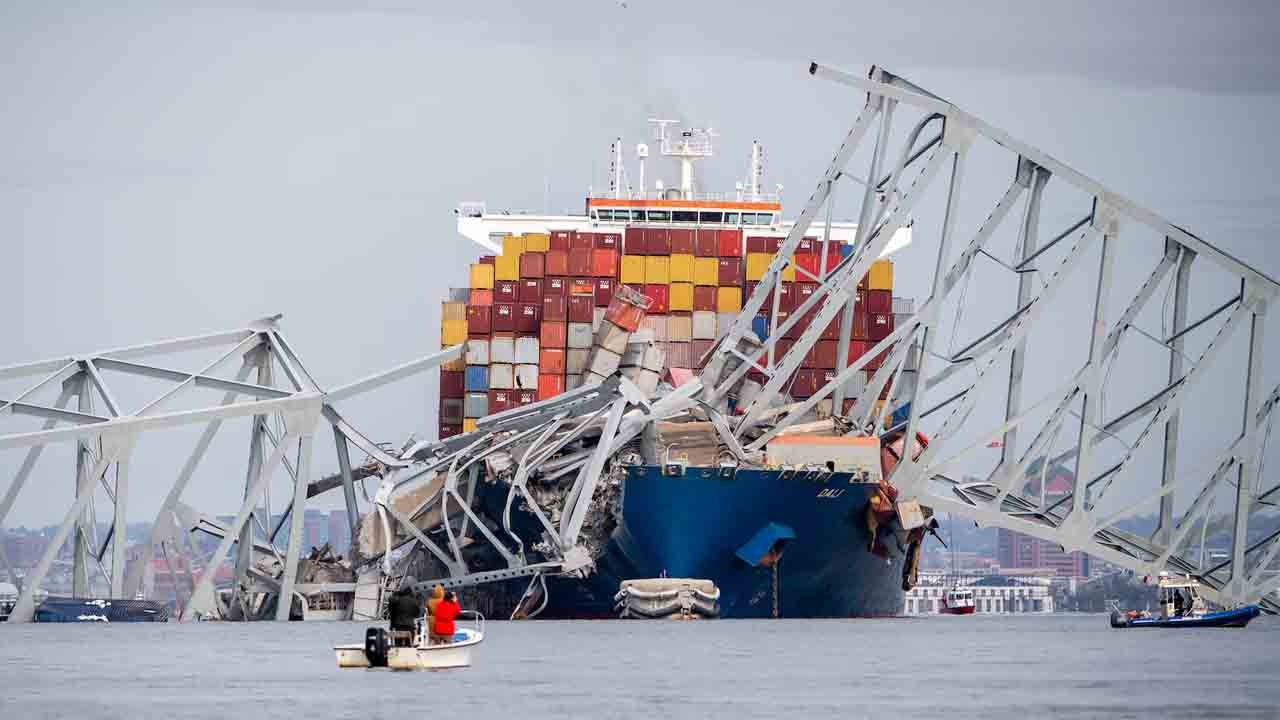Last week’s deadly bridge accident had indefinitely closed the country’s 17th largest port and its busiest gateway for vehicles. Changes to the schedule are expected at neighboring facilities with additional capacity.
The US East Coast port is changing its procedures for removing cargo shipped from the Port of Baltimore, while salvage experts begin the difficult process of removing debris from the damaged Francis Scott Bridge.
The Port of Virginia, with a terminal at the mouth of the Chesapeake Bay near Norfolk, is opening a gate at 5 a.m. Monday, an hour earlier than usual, to help accommodate more truckers. The ports of New York and New Jersey, which are expecting additional cargo, including autos, are working to give transportation companies quicker access from Baltimore. A major railway has also increased its services.
Last week’s deadly bridge accident had indefinitely closed the country’s 17th largest port and its busiest gateway for vehicles. Changes to the schedule are expected at neighboring facilities with additional capacity. Requiring longer routes on already congested roadways and rail lines for thousands of shipments is more likely to see congestion, delays and additional expense outside ports.
“Ports on the East Coast can easily absorb the immediate fallout of containerized trade,” said San Manders, president of international operations for digital freight platform Flexport Inc. The long-term consequences will likely be more severe, because even if you remove the debris from the port “It is an extremely important bridge as a feeder into the port, and the traffic will have to travel a long distance.”
CSX Corp. of Jacksonville, Florida, announced it is launching rail service designed to divert freight from New York to Baltimore.
According to analysis by the International Monetary Fund (IMF)’s PortWatch platform, destinations for cargo ships frequently leaving Baltimore on scheduled routes include Norfolk, New York and Charleston, South Carolina. This is likely to make them absorb more imports.
As of Sunday, 29 bulk cargo, container and vehicle carriers were anchored outside 10 ports between Boston and Jacksonville, according to satellite tracking data compiled by Bloomberg. This number was 18 on Saturday.
Late Sunday, Baltimore City Mayor Brandon Scott said officials planned to create a temporary channel on the northeast side of the main channel around the Francis Scott Bridge for commercially essential vessels.
The permanent channel will be marked with government lights for navigation, with a controlled depth of 11 feet, horizontal clearance of 264 feet and vertical clearance of 96 feet. At present, a security zone of 2,000 yards is in place around the bridge.
Maryland Governor Wes Moore said port closures would have a widespread impact in the eastern US. On CNN’s State of the Union, he said, “This port is one of the busiest ports in the country, so this will impact farmers in Kentucky, auto dealers in Ohio and restaurant owners in Tennessee.”
Gateways including New York and Virginia are handling about 20% less volume than during the peak of the pandemic, giving officials a sense they have a greater ability to avoid expansion.
If all goes according to plan, truckers at other terminals in the region should do the same this week who book pick-up and drop-off appointments in Baltimore.
“The Ports of New York and New Jersey are actively working with our industry partners to respond as needed and ensure supply chain continuity on the East Coast,” port director Bethan Rooney said in an email.
FourKites Inc.’s supply-chain visibility platform reported a five-day turnaround in delivery times over ground modes of transportation.
Jason Eversole, vice president of professional services at FourKites, said, “Once they remove debris from the water, traffic in the area will still be affected because truck drivers will be reluctant to move goods in and out of the area without a price increase. “”
Many economists said the local devastation caused by the Port of Baltimore and the collapsed bridge would continue for months.
This economic impact is relatively small, but it is another glaring example of a supply-chain shock to a globally connected hub, which has raised concerns in political circles and corporate boardrooms that greater resilience and self-reliance is needed.
The setbacks, such as delays in ships sailing around Africa or transiting the drought-stricken Panama Canal to avoid Houthi attacks in the Red Sea, have been seen around the world.
And other threats that harm local economies, such as port strikes in Finland; South Africa’s reliable logistics system; And earlier this month a container ship collided with a dockside crane and crashed.
“Trade is actually going very well — trade flows are still growing, companies are looking for work, and most of the disruption seems to be temporary,” said Shanela Rajanayagam, trade economist at HSBC Holdings Plc in London.
HSBC economists have pegged global trade growth at 2.5% this year and forecast a 3.4% expansion by 2025. This would be a huge improvement from 2023, but many analysts think no growth will be seen once the final figures are out.
Rajanayagam said container shipping rates from Asia to the US East Coast may have temporarily increased after the Baltimore disaster, but geopolitics, protectionism, election-year uncertainty and climate change remain major threats to global commerce.
“It all seems to be pointing to the downside rather than the upside, so it makes sense to be prepared for those shocks,” he said.

